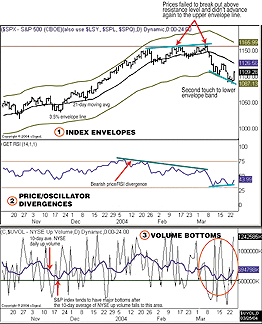Simple But Effective
Spotting Index Tops And Bottoms
by Leigh Stevens
Use these techniques to buy index options ahead of market reversals.
There are two principal ways of trading stock indexes with leverage. One is using stock index futures, and the other is using stock index options such as the Standard & Poor's 500 (SPX), the S&P 100 (OEX), and the Dow Jones index (DJX) options. The futures markets do not offer as much leverage as stock index options (nor do they offer the same hedging opportunities), but trading futures does remove the calculation of time premiums involved in buying calls and puts. Because premiums for index options get inflated quickly in a strongly trending and/or volatile market, astute market timing tends to be even more critical. You may be right on the trend in index options, but still not make any money if inflated premiums erode faster than the market moves.
SOME OBSERVATIONS
In index futures like the S&P, I found that I could buy and sell (short) breakouts and make money. However, I would often lose on trades when I bought call or put options like the OEX after a breakout move occurred. To make a consistent and optimal profit, I needed to anticipate the price and time frame when the market was making a significant top or bottom, and buy index options ahead of market reversals. In this way the premiums were reasonable, and I could more comfortably hold a position for some time when a move was especially strong.
In studying this problem, I found a combination of three technical circumstances that, while not appearing frequently, worked well as a signal for purchasing index call and put options. A buy side occurrence that often highlights a high-potential trade ahead of trend reversals is revealed by using moving average envelopes, price/oscillator divergences, and a 10-day average of the New York Stock Exchange (NYSE) daily up volume.

Figure 1: Simple but powerful. Here are three techniques at work: Moving average envelopes, price/oscillator divergences, and a 10-day average of NYSE daily up volume for bottoms.
These techniques are simple, and that can actually protect them
from becoming overused. There is a tendency among traders not to follow
overly simple techniques, even though there is plenty of evidence that
doing so could be advantageous. For example, does everyone do what Warren
Buffett does? Most of us don't have the patience to wait just for the right
time and price. Buffett's methods aren't especially complex, but he buys
and sells ahead of the crowd -- he buys 'em when nobody wants 'em or mostly
so.
...Continued in the August issue of Technical Analysis of STOCKS & COMMODITIES
Excerpted from an article originally published in the August 2004 issue of Technical Analysis of STOCKS & COMMODITIES magazine. All rights reserved. © Copyright 2004, Technical Analysis, Inc.